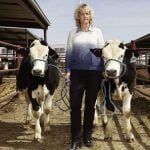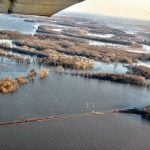Waterhemp, Canada fleabane and other tough weeds pose an increasing challenge in soybeans. These weeds can have significant impact on yield and continue to quickly adapt to a variety of herbicide groups. Bayer’s updated Roundup Ready® Xtend Crop System protection products – Roundup Xtend® 2 and XtendiMax® 2 are designed to tackle these tough to control weeds head-on, while mitigating the risk of off-target impacts.
Early and residual control
 Bryan Bryson, Traits and Licensing Campaign Manager at Bayer
Bryan Bryson, Traits and Licensing Campaign Manager at BayerXtendiMax® 2 with VaporGrip® Technology and Roundup Xtend® 2 with VaporGrip® Technology are more concentrated than earlier offerings, meaning they cover more acres with less volume in the Roundup Ready® Xtend Crop System. Both old and new formulations target a range of early-season broadleaf weeds, including glyphosate-resistant populations.
“The Roundup Ready Xtend Crop System is about bringing another mode of action to soybean weed control. XtendiMax 2 with VaporGripTechnology and Roundup Xtend 2 with VaporGrip Technology utilize dicamba which can be sharper on broadleaves that maybe need a little more kick,” says Bryan Bryson, Traits and Licensing Campaign Manager for Bayer.
“It’s important to apply herbicides early in the season when weeds are smaller and generally easier to control,” he says. “Some of these weeds and resistant weeds, like waterhemp and Canada fleabane, travel and establish populations very quickly. That short term residual control is what makes a difference here – you’re knocking the weeds down that are already there at application, plus getting the benefit of that short-term residual control.”
Know when to spray
XtendiMax 2 with VaporGrip Technology and Roundup Xtend 2 with VaporGrip Technology herbicides can be applied from pre-plant to R1 stage, though it’s recommended to spray early (pre-plant through post-emergence). All crop protection products require proper handling and application. Off-target movements are a concern for all crop protection products, so tools and knowledge are key to help mitigate these risks, one of which are temperature inversions.
Temperature inversions occur when cooler air settles near the earth’s surface and ceases to mix with the air above. Typically occurring at or shortly after sunset, herbicide particles can be suspended in the stable air mass. Once conditions change and the previously stable air mass moves, the suspended herbicide particles move with it, potentially damaging crops some distance away from the application site.
Consulting labels for application window restrictions and how the herbicides should be applied, is a critical step in mitigating the risk of off-target effects, Bryson says. Best practices include spraying when temperature inversions are unlikely, in low wind, and with nozzles capable of emitting coarse to ultra-coarse droplets. Respecting buffers and environmentally sensitive areas, thoroughly cleaning tanks, lines and washing equipment, as well as not driving too fast during application go a long way. Ensuring herbicide is applied when weeds are less than 10 centimetres in height, too, provides much better control.
Farmers should be aware of products that increase the risk of volatilization when combined, like ammonium sulphate and dicamba, and consider formulations containing VaporGrip, which are specifically designed to lower volatilization risk when all product use directions are followed.
“VaporGrip prevents dicamba ions from combining with hydrogen and significantly reduces volatility. Crop protection manufacturers and solution providers are always trying to improve performance and reduce risk. VaporGrip is part of that,” he says.
Grower resources
Bayer is committed to working with farmers to ensure they’re able to maximize tools when tackling problem weeds.
Bayer’s free-to-access Spray Forecast Tool (www.sprayforecast.ca) for example, provides an evaluation of temperature inversion risk based on the user’s chosen location. Account managers, partnering agronomists and retailers and other Bayer representatives can be great references to provide valuable expertise and experience.
“We put a lot of energy into connecting with external folks in extension and academia as well. These connections help make sure the right information is shared and broadly available,” Bryson says.










